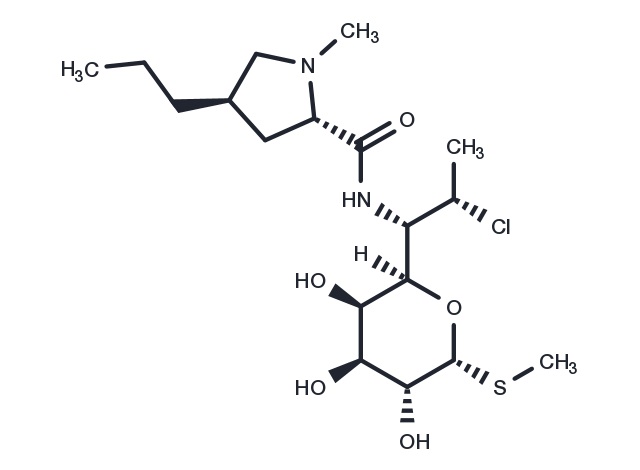Powder: -20°C for 3 years | In solvent: -80°C for 1 year


Clindamycin (Sobelin) dissociates peptidyl-tRNA from the bacterial ribosome, thereby disrupting bacterial protein synthesis. Clindamycin is a semisynthetic broad-spectrum antibiotic produced by chemical modification of the parent compound lincomycin.

| Pack Size | Availability | Price/USD | Quantity |
|---|---|---|---|
| 25 mg | In stock | $ 42.00 | |
| 50 mg | In stock | $ 59.00 | |
| 100 mg | In stock | $ 81.00 | |
| 1 mL * 10 mM (in DMSO) | In stock | $ 50.00 |




| Description | Clindamycin (Sobelin) dissociates peptidyl-tRNA from the bacterial ribosome, thereby disrupting bacterial protein synthesis. Clindamycin is a semisynthetic broad-spectrum antibiotic produced by chemical modification of the parent compound lincomycin. |
| In vitro | Clindamycin is a semisynthetic analogue of lincomycin. Clindamycin primarily inhibits the initiation of peptide chain synthesis by deregulating enzyme-catalyzed initiation of peptide bounds. Clindamycin appears to have a modest effect on protein synthesis by certain mammalian cells. [1] Clindamycin is active against most gram-positive aerobic bacteria. Clindamycin is about eight times more active than lincomycin against Staphylococcus aureus and Streptococcus pneumonia. Clindamycin is four times more active than erythromycin against S. aureus and is active even against strains that are resistant to erythromycin, penicillin, and methicillin. Clindamycin is active against gram-positive anaerobes. Clindamycin highly activates against Bacteroides specie. [2] Clindamyci also alters the bacterial surface in such a way that phagocytosis and intracellular killing of the bacteria is greatly facilitated. Clindamycin potentiates opsonization and phagocytosis. [4] |
| In vivo | Clindamycin (50 mg/kg daily administrated by intramuscular) increases the survival rate of monkeys infected with penicillin-resistant S. aureu to 87.5% (7/8). [5] Clindamycin (40 mg/kg administrated three times daily) protects 87.5% (7/8) of rabbits from anaerobic pulmonary infections induced by transtracheal inoculation of a mixture of B. fragillis, Streptococcus morbillorm, Fusobacterium nucleatum and Eubacterium lentum. [6] Clindamycin (400 mg/kg treated by mixed in the diet) increases survival rate of mice infected with the Toxoplasma gondii to 100%, while all animals die in untreated group. [7] |
| Synonyms | Clinimycin, Sobelin, Chlolincocin |
| Molecular Weight | 424.98 |
| Formula | C18H33ClN2O5S |
| CAS No. | 18323-44-9 |
Powder: -20°C for 3 years | In solvent: -80°C for 1 year
DMSO: 79 mg/mL (185.9 mM)
Ethanol: 79 mg/mL (185.9 mM)
H2O: < 1 mg/mL (insoluble or slightly soluble)
You can also refer to dose conversion for different animals. More
bottom
Please see Inhibitor Handling Instructions for more frequently ask questions. Topics include: how to prepare stock solutions, how to store products, and cautions on cell-based assays & animal experiments, etc.
Clindamycin 18323-44-9 Microbiology/Virology Antibiotic Antibacterial broad-spectrum Clinimycin Sobelin Parasite Inhibitor inhibit Chlolincocin bacteriostatic Bacterial lincosamide malaria inhibitor
